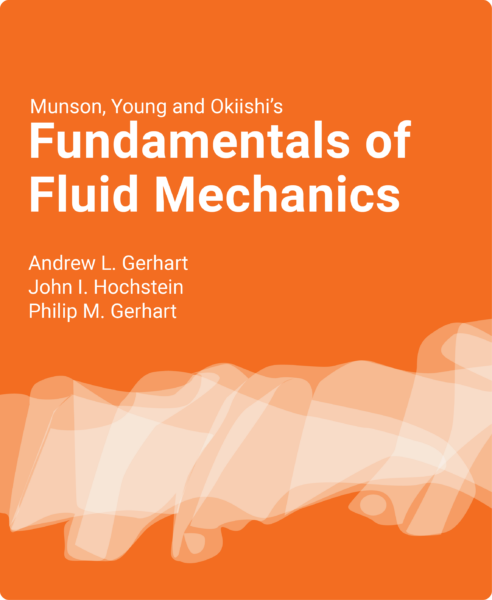Table of Contents
1. Introduction
1.1 Some characteristics of fluids
1.2 Dimensions, dimensional homogeneity, and units
1.3 Analysis of fluid behavior
1.4 Measures of fluid mass and weight
1.5 Ideal gas law
1.6 Viscosity
1.7 Compressibility of fluids
1.8 Vapor pressure
1.9 Surface tension
1.10 A brief look back in history
1.11 Chapter summary
1.12 Key equations
1.13 References
1.14 Problems
2. Fluid Statics
2.1 Pressure at a point
2.2 Basic equation for pressure field
2.3 Pressure variation in a fluid at rest
2.4 Standard atmosphere
2.5 Measurement of pressure
2.6 Manometry
2.7 Mechanical and electronic pressure-measuring devices
2.8 Hydrostatic force on a plane surface
2.9 Pressure prism
2.10 Hydrostatic force on a curved surface
2.11 Buoyancy, flotation, and stability
2.12 Pressure variation in a fluid with rigid-body motion
2.13 Chapter summary
2.14 Key equations
2.15 References
2.16 Problems
3. Elementary Fluid Dynamics—The Bernoulli Equation
3.1 Newton’s second law
3.2 F = ma along a streamline
3.3 F = ma normal to a streamline
3.4 Physical interpretations and alternate forms of the Bernoulli equation
3.5 Static, stagnation, dynamic, and total pressure
3.6 Examples of use of the Bernoulli equation
3.7 The energy line and the hydraulic grade line
3.8 Restrictions on use of the Bernoulli equation
3.9 Chapter summary
3.10 Key equations
3.11 References
3.12 Problems
4. Fluid Kinematics
4.1 The velocity field
4.2 The acceleration field
4.3 Control volume and system representations
4.4 The Reynolds transport theorem
4.5 Chapter summary
4.6 Key equations
4.7 References
4.8 Problems
5. Finite Control Volume Analysis
5.1 Conservation of mass—the continuity equation
5.2 Newton’s second law—the linear momentum equation
5.3 Newton’s second law—the angular momentum equation
5.4 First law of thermodynamics—the energy equation
5.5 Second law of thermodynamics—irreversible flow
5.6 Chapter summary
5.7 Key equations
5.8 References
5.9 Problems
6. Differential Analysis of Fluid Flow
6.1 Fluid element kinematics
6.2 Conservation of mass
6.3 The linear momentum equation
6.4 Inviscid flow
6.5 Some basic, plane potential flows
6.6 Superposition of basic, plane potential flows
6.7 Other aspects of potential flow analysis
6.8 Viscous flow
6.9 Some simple solutions for laminar, viscous, incompressible flows
6.10 Other aspects of differential analysis
6.11 Chapter summary
6.12 Key equations
6.13 References
6.14 Problems
7. Dimensional Analysis, Similitude, and Modeling
7.1 The need for dimensional analysis
7.2 Buckingham pi theorem
7.3 Determination of pi terms
7.4 Some additional comments about dimensional analysis
7.5 Determination of pi terms by inspection
7.6 Common dimensionless groups in fluid mechanics
7.7 Correlation of experimental data
7.8 Modeling and similitude
7.9 Some typical model studies
7.10 Similitude based on governing differential equations
7.11 Chapter summary
7.12 Key equations
7.13 References
7.14 Problems
8. Viscous Flow in Pipes
8.1 General characteristics of pipe flow
8.2 Fully developed laminar flow
8.3 Fully developed turbulent flow
8.4 Pipe flow losses via dimensional analysis
8.5 Pipe flow examples
8.6 Pipe flowrate measurement
8.7 Chapter summary
8.8 Key equations
8.9 References
8.10 Problems
9. Flow over Immersed Bodies
9.1 General external flow characteristics
9.2 Boundary layer characteristics
9.3 Drag
9.4 Lift
9.5 Chapter summary
9.6 Key equations
9.7 References
9.8 Problems
10. Open-Channel Flow
10.1 General characteristics of open-channel flow
10.2 Surface waves
10.3 Energy considerations
10.4 Uniform flow
10.5 Gradually varied flow
10.6 Rapidly varied flow
10.7 Chapter summary
10.8 Key equations
10.9 References
10.10 Problems
11. Compressible Flow
11.1 Ideal gas thermodynamics
11.2 Stagnation properties
11.3 Mach number and speed of sound
11.4 Compressible flow regimes
11.5 Shock waves
11.6 Isentropic flow
11.7 One-dimensional flow in a variable area duct
11.8 Constant-area duct flow with friction
11.9 Frictionless flow in a constant-area duct with heating or cooling
11.10 Analogy between compressible and open-channel flows
11.11 Two-dimensional supersonic flow
11.12 Effects of compressibility in external flow
11.13 Chapter summary
11.14 Key equations
11.15 References
11.16 Problems
12. Turbomachines
12.1 Introduction
12.2 Basic energy considerations
12.3 Angular momentum considerations
12.4 The centrifugal pump
12.5 Dimensionless parameters and similarity laws
12.6 Axial-flow and mixed-flow pumps
12.7 Fans
12.8 Turbines
12.9 Compressible flow turbomachines
12.10 Chapter summary
12.11 Key equations
12.12 References
12.13 Problems
13. Appendix A: Computational Fluid Dynamics
13.1 Introduction
13.2 A very simple example
13.3 Discretization
13.4 The computational grid
13.5 Boundary conditions
13.6 Turbulence models
13.7 Solving the equations
13.8 Some unexpected complications
13.9 Verification and validation
13.10 Application of CFD
13.11 Appendix summary
13.12 References
14. Appendix B: Physical Properties of Fluids
14.1 Physical properties of fluids
14.2 Physical properties of common liquids and gases
15. Appendix C: Properties of the U.S. Standard Atmosphere
15.1 Properties of the U.S. Standard Atmosphere
16. Appendix D: Compressible Flow Functions for an Ideal Gas with k = 1.4
16.1 Compressible flow functions for an ideal gas with k = 1.4
17. Appendix E: Comprehensive Table of Conversion Factors
17.1 Comprehensive table of conversion factors
18. Appendix F: Conversion Factors (continued)
18.1 Conversion factors (continued)
19. Appendix G: Moody Chart and Equivalent Roughness Table
19.1 Moody chart and equivalent roughness table
Same Text, More Action
Based on the 9th edition of Munson, Young, and Okiishi’s Fundamentals of Fluid Mechanics, this zyVersion contains the complete text of the original book plus new interactive animations, learning questions, and challenge activities to engage the student.
- 70 dynamic animations provide insight into numerous topics
- More than 750 individual questions make up learning question sets that will help students understand topics through incremental steps keeping students engaged and providing thorough explanations of both right and wrong answers
- Over 100 Challenge Activities (“homework problems”) provide algorithmic, auto-graded versions of the end-of-chapter problems in the original text
- Numerous video segments are integrated throughout the zyVersion to illustrate interesting and practical applications of real-world fluid phenomena
- Approximately 60 short “The Wide World of Fluids” stories reflect important and novel ways that fluid mechanics affects our lives
- Adopters have access to a test bank with questions for every chapter
Optional Challenge Activities
As an instructor, you have the ability to mark Challenge Activities as optional, which means you can indicate which Challenge Activities your students need to complete in order to meet your course requirements. Those marked as optional won’t contribute to point totals in reports or assignments.
What is a zyVersion?
zyVersions are leading print titles converted and adapted to zyBooks’ interactive learning platform, allowing for a quick and easy transition to an engaging digital experience for instructors and students.
zyBooks’ web-native content helps students visualize concepts to learn faster and more effectively than with a traditional textbook.
This zyVersion of Munson, Young, and Okiishi’s Fundamentals of Fluid Mechanics benefits both students and instructors:
- Instructor benefits
- Customize your course by reorganizing existing content, or adding your own content
- Continuous publication model updates your course with the latest content and technologies
- Robust reporting gives you insight into students’ progress, reading and participation
- Student benefits
- Learning questions and other content serve as an interactive form of reading and provide instant feedback
- Concepts come to life through extensive animations embedded into the interactive content
- Save chapters as PDFs to reference material at any time, even after the course has been completed
Authors
Andrew L. Gerhart
Lawrence Technological University
John I. Hochstein
University of Memphis
Philip M. Gerhart
University of Evansville
Key Contributors
Alicia Clark
Content Developer, zyBooks
Lauren Fogg
Associate Content Developer, zyBooks
Oscar Rios
Content Developer, zyBooks



